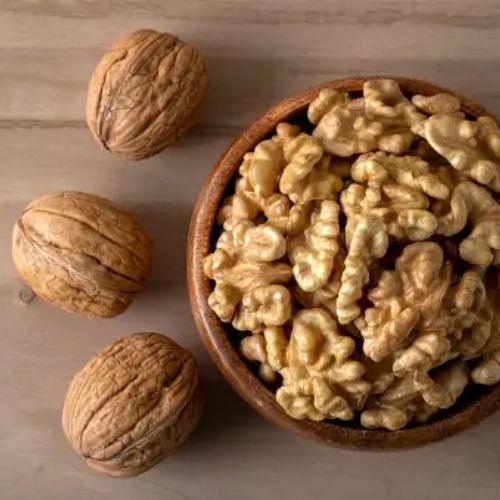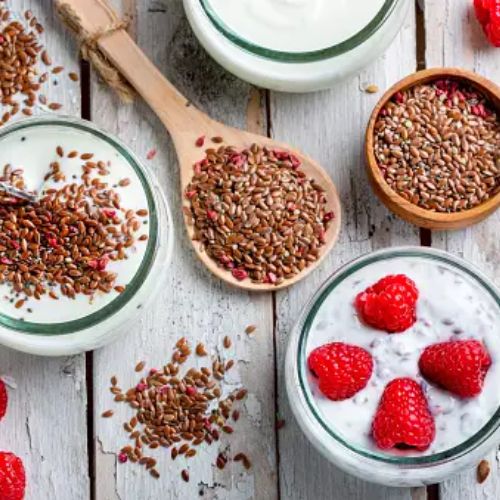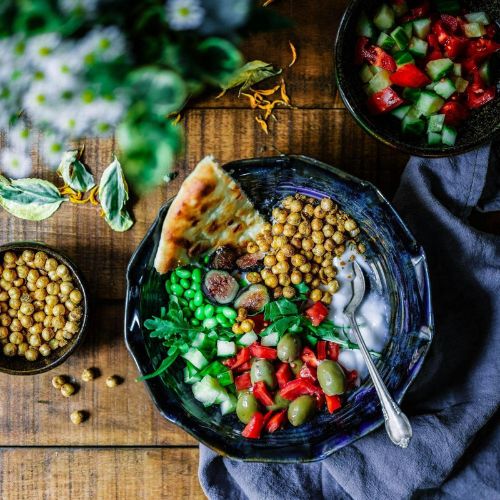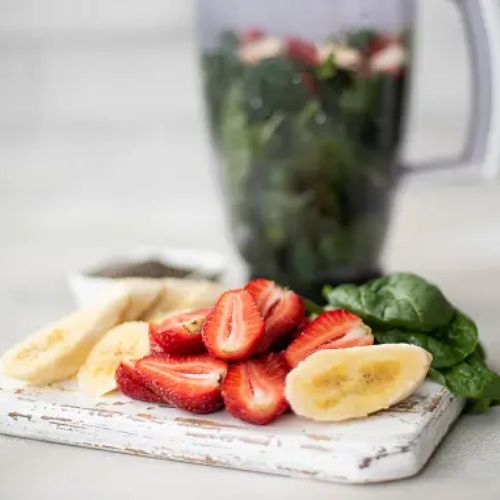Are you getting enough of Omega-3s as a vegan? Is it from the right source?
Dive in to learn about the best and worst sources of this essential nutrient and ensure your vegan diet is on point.
The Omega-3 Mystery
Omega-3s are essential fats that our bodies can’t produce. They play a crucial role in brain function, heart health and mood regulation, acting like the oil that keeps our body’s engine running smoothly. For vegans, it’s vital to get Omega-3s from plant-based sources.
But where can you get them on a vegan diet? Let’s break it down!
Best Sources of Vegan Omega-3s
1. Flaxseeds

Flaxseeds are a fantastic source of omega-3 fatty acids, especially alpha-linolenic acid (ALA). One tablespoon of ground flaxseeds can give you a good chunk of your daily omega-3 needs.
Flaxseeds are super versatile — you can sprinkle them on your morning oatmeal, blend them into smoothies, mix them into salads, or even bake them into your favourite treats. Plus, they come with the bonus of fibre and lignans, which help with digestion and reduce inflammation.
For the best results, consuming them in ground form is ideal so your body can absorb all those great nutrients.
2. Chia Seeds

Chia seeds are another powerhouse of omega-3s, particularly ALA. These tiny seeds are incredibly easy to incorporate into your diet. You can toss them into your smoothies or yoghurt or sprinkle them on cereal.
Chia seeds also make a great base for chia pudding, a delicious and healthy snack. In addition to omega-3s, they’re packed with fibre, protein and essential minerals, making them a well-rounded addition to your meals.
3. Walnuts

Walnuts are a delicious and convenient source of omega-3s. Just a handful can provide a healthy dose of ALA, protein and antioxidants.
Walnuts make a great snack, but you can also add them to salads for a crunchy texture or mix them in baked goods. They are also heart-healthy and can help lower bad cholesterol levels, making them a tasty and nutritious choice.
4. Hemp Seeds

Hemp seeds are a versatile and nutritious source of omega-3 fatty acids. Their mild, nutty flavour works well in a variety of dishes. Sprinkle them on salads, blend them into smoothies, or mix them into your morning oatmeal.
Hemp seeds are also rich in protein, fibre and essential minerals, making them a great addition to your diet for overall health and wellness.
5. Algal Oil
Algal oil is a lesser-known but highly effective source of omega-3s, particularly DHA and EPA, the same types found in fish oil. Since it’s derived from algae, it’s an entirely plant-based option.
Algal oil supplements are available if you’re looking for a straightforward way to boost your omega-3 intake. It’s an excellent choice for those with trouble incorporating enough omega-3s through food alone.
Plus, it’s sustainable and environmentally friendly, making it a win-win for your health and the planet.
Honourable Mentions
6. Brussels Sprouts

Brussels sprouts may not be the first thing that comes to mind when thinking of omega-3s, but these little green veggies are a great source. They contain ALA, which supports heart health and reduces inflammation.
You can roast, steam, or even shred them raw into salads. In addition to their omega-3 content, Brussels sprouts are packed with vitamins K and C, fibre and antioxidants, making them a nutritious and versatile addition to any meal.
7. Perilla Oil
Perilla oil, derived from perilla seeds, is a fantastic source of ALA omega-3 fatty acids. This oil is commonly used in Korean cuisine and has a unique, nutty flavour. You can use it as a finishing oil for salads and soups or even drizzle it over roasted vegetables.
It’s also available in supplement form for those who prefer an easier way to ensure they get their omega-3s. Perilla oil not only provides omega-3s but also contains antioxidants and anti-inflammatory properties, making it a healthy and flavorful addition to your diet.
Worst Sources of Vegan Omega-3s
1. Vegetable Oils (Except Flaxseed and Hemp Oil)

While some vegetable oils, like flaxseed and hemp oil, are excellent sources of omega-3s, many common oils, such as corn oil, sunflower oil and palm oil, are poor sources.
These oils are often high in omega-6 fatty acids, which can interfere with the absorption and effectiveness of omega-3s in the body.
Consuming a high ratio of omega-6 to omega-3 can lead to inflammation and other health issues. It’s best to limit these oils and focus on better sources of omega-3s.
2. Processed Vegan Foods
Processed vegan foods, like burgers, sausages and other convenience items, often lack significant omega-3s. These products are typically made with refined oils and fillers that do not provide the essential fatty acids your body needs.
Moreover, processed foods can be high in sodium, unhealthy fats and artificial ingredients, which can counteract the benefits of a balanced diet. To ensure adequate omega-3 intake, opt for whole, plant-based foods instead of heavily processed options.
3. Soy Products

Soy products, including tofu, tempeh and soy milk, are excellent sources of protein and other nutrients but are not particularly high in omega-3s. While soy does contain some alpha-linolenic acid (ALA), the amount is relatively low compared to other sources, such as chia seeds or walnuts.
The high omega-6 content in soy products can also overshadow the benefits of the omega-3s they contain. Combine soy products with omega-3-rich foods to balance your intake and ensure you get enough essential fatty acids.
Making the Most of Your Omega-3s

Eat a Variety
Don’t stick to just one source. Mix it up to ensure you’re getting a good balance. Variety ensures you get a range of nutrients and benefits from different foods.
Watch Your Ratios
Aim for a balanced ratio of Omega-6 to Omega-3. Too much Omega-6 can negate the benefits of Omega-3s. Focus on reducing high Omega-6 foods like processed snacks and oils.
Consider Supplements
If you struggle to get enough from food, consider a vegan Omega-3 supplement. Algal oil is a great option. Consult a healthcare professional before starting any supplement to ensure it fits your needs.
Fun Ways to Include Omega-3s

Smoothie Time!
Add a tablespoon of flaxseeds or chia seeds to your morning smoothie for an Omega-3 boost. For a nutrient-packed start to your day, try a berry and banana smoothie with a handful of spinach and a spoonful of flaxseeds.
Nutty Snacks
Keep a bag of mixed nuts, such as walnuts and hemp seeds, handy for a quick and healthy snack. Make your own trail mix with dried fruit and dark chocolate chips for a delicious treat.
Creative Cooking
Use hemp oil in your salad dressings or drizzle it over roasted veggies for a nutty flavour and health boost. Experiment with different recipes to find your favourite combinations.
Delicious Desserts

Incorporate flaxseed meal into your baking. Flaxseed cookies or chia seed puddings are delicious ways to boost your Omega-3 intake.
Debunking Myths
Myth: Only Fish Have Omega-3s
Reality: Many plant-based sources are rich in Omega-3s and you can thrive on a vegan diet with the right choices. Plants offer various options that can be just as beneficial as fish.
Myth: Omega-3 Supplements Are Essential
Reality: While supplements can help, many vegans get enough Omega-3s from a well-planned diet. Focus on incorporating a variety of sources into your meals.
Final Thoughts
So, there you have it! You’ll support your overall health and well-being by making informed choices and including these top sources of vegan Omega-3s in your diet. Happy munching and may your Omega-3s be ever in your favour!

I’ve recently transitioned to a vegan diet for my athletic training, and I’m curious about the optimal ways to incorporate omega-3s. Can you recommend the best balance of these foods to support high-performance activities?
Love seeing algal oil getting a shoutout! It’s such a sustainable option and not talked about enough. Great list, it’s important for our planet and health.
Seems like another article telling us to eat weird stuff. Whatever happened to just eating normal food and calling it a day?
While I appreciate the focus on plant-based sources, there’s considerable debate about the bioavailability of ALA from seeds compared to EPA and DHA from marine sources. Thoughts?
Actually, NootropicNick, the body can convert ALA to EPA and DHA, though the conversion rates are low. Supplementation or direct sources like algal oil might be necessary for optimal levels.
This is just what I needed! Been trying to get the family on healthier snacks and those nutty snacks sound like a winner. Thanks!
On the point about vegetable oils being poor sources of Omega-3s, it’s important to note that while they do contain some Omega-3s, the omega-6 to omega-3 ratio is often very high, which isn’t great.
Definitely going to try adding hemp seeds to my next dish. Sounds like an easy way to boost nutrition without changing the taste much. Cheers for the suggestion.
Wait, you’re telling me these plant things have omega-3s? Might as well stick to my fish oil, but hey, you do you.
It’s essential to highlight that there are viable vegan options for omega-3s, but we also need to address how we can encourage better absorption of these nutrients through our diet.
Is there a specific ratio of omega-6 to omega-3 that we should aim for in our diets? I’ve read conflicting information on this topic.
CuriousChris, it’s generally recommended to aim for a ratio between 2:1 and 4:1 of omega-6 to omega-3. Most western diets are way off this balance, though.